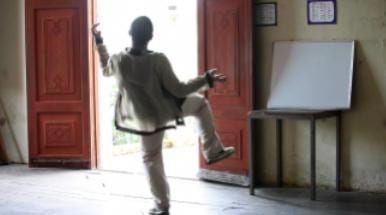Peter Chin still speaks with just a hint of a Jamaican accent. The gay Canadian dance artist’s family left the island nation for Canada when he was five. But instead of settling in the true north permanently, his family moved back and forth throughout his youth. In addition to teaching certain practicalities (he knows how to pack light), the constant movement imbued a sense of always being a foreigner.
“There was this idea of always trying to reintegrate into different places, which I still experience today,” he says. “When I’m in Jamaica, my accent really comes out, which confuses people because I’m three quarters Chinese, so I don’t really look Jamaican.”
Learning languages as a foreigner was a core inspiration for Fluency, Chin’s new piece that explores his attempts to learn Spanish while travelling in Nicaragua. Based on a series of interviews he did with people in various parts of the country over three years, the piece examines what it means to immigrate and integrate. But rather than approach things as a tourist, the question Chin posed in his travels was whether he could actually become Nicaraguan, a proposition with a decidedly political slant.
“It’s the second poorest country in the Western Hemisphere after Haiti,” he says. “No one bats an eye at the idea of someone wanting to become Canadian. But the idea of someone wanting to become Nicaraguan seems ridiculous. As an immigrant to a wealthy Western country myself, I was fascinated by this divide.”
The resulting work is a hybrid dance theatre piece translating Chin’s experiences through video, movement and text. Although he’s no stranger to multimedia, the piece represents something of a departure for Chin who is best known for his kinetic choreography. Much of the work features Chin sitting on a couch, being interviewed about his experiences in Nicaragua.
“A lot of the questions you’re asking me are actually asked in the piece itself,” he laughs. “The interviewer in the piece is very sensational and quite sceptical, though. It’s actually a very funny show, which is an important element because we’re proposing some bold ideas about what it means to live in a globalized culture and the responsibilities that citizens of wealthy countries have to the world, but often ignore.”
Though not a recreation of the now infamous Sun TV interview, in which veteran Canadian choreographer Margie Gillis is accosted about arts funding, Chin had that event percolating in his mind during the creative process. The June 2011 TV spot, which generated a record number of complaints to the Canadian Broadcast Standards Council, served as a rallying call to the arts community to defend and promote their values to the nation.
“We were already working on the project when it happened, but the whole artistic community was talking about it, so we couldn’t ignore its implications,” he says. “There is a growing climate of suspicion and anger towards the arts, and we need to deal with it head on. The things artists offer aren’t always quantifiable. But that doesn’t mean they aren’t incredibly valuable to our society.”
More recently, Rob Ford’s decision to skip the annual Mayor’s Arts Awards Lunch for the Toronto Arts Foundation, as well as his decision to opt-out of anything Pride related, has Chin concerned.
“The suggestion is that he just doesn’t care, but I think it actually a more dangerous apathy to difference,” Chin says. “Our family came here as foreigners in part because of the celebration of diversity. But the current political climate is regressive and the mayor is the our worst enemy in the fight for progress right now.”
The Deets:
DanceWorks presents
Tribal Crackling Wind’s Fluency
Choreography by Peter Chin
Nov 3 – 5 at 8pm
Harbourfront Centre’s Enwave Theatre
231 Queens Quay West
danceworks.ca


 Why you can trust Xtra
Why you can trust Xtra


